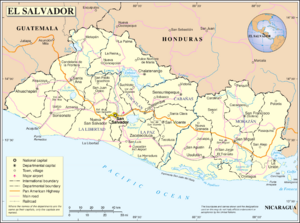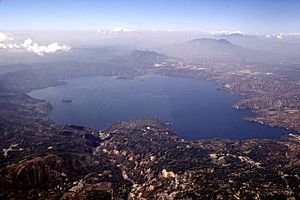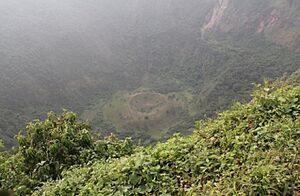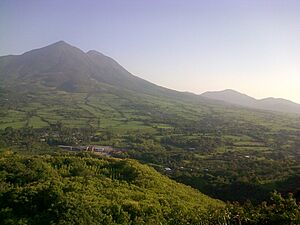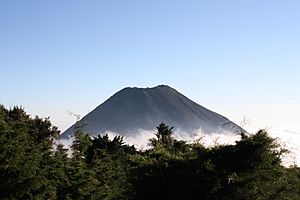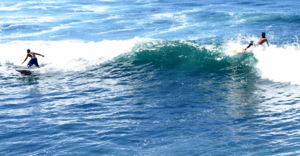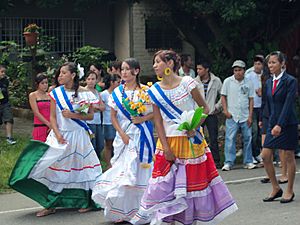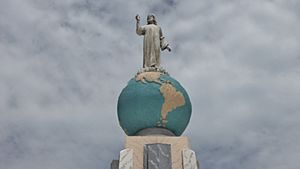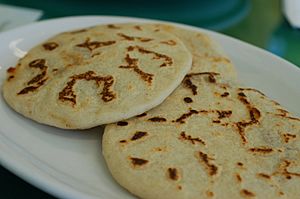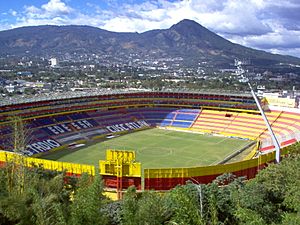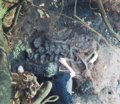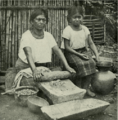El Salvador facts for kids
Quick facts for kids
Republic of El Salvador
República de El Salvador (Spanish)
|
|
|---|---|
|
|
|
|
Motto: Dios, Unión, Libertad
"God, Union, Liberty" |
|
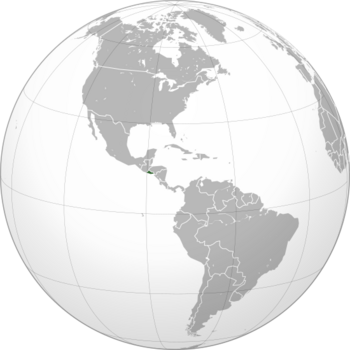 |
|
 |
|
| Capital and largest city
|
San Salvador 13°41′56″N 89°11′29″W / 13.69889°N 89.19139°W |
| Official languages | Spanish |
| Ethnic groups |
|
| Religion
(2017)
|
|
| Demonym(s) | Salvadoran |
| Government | Unitary presidential republic |
| Nayib Bukele | |
| Félix Ulloa | |
| Legislature | Legislative Assembly |
| Independence | |
|
• Declared from Spain
|
15 September 1821 |
|
• Declared from the First Mexican Empire
|
1 July 1823 |
|
• Declared from the
Federal Republic of Central America |
30 January 1841 |
|
• International recognition
|
18 February 1841 |
| Area | |
|
• Total
|
21,041 km2 (8,124 sq mi) (148th) |
|
• Water (%)
|
1.5 |
| Population | |
|
• 2023 estimate
|
6,602,370 (109th) |
|
• Density
|
324.4/km2 (840.2/sq mi) (26th) |
| GDP (PPP) | 2023 estimate |
|
• Total
|
|
|
• Per capita
|
|
| GDP (nominal) | 2023 estimate |
|
• Total
|
|
|
• Per capita
|
|
| Gini (2022) | medium |
| HDI (2022) | medium · 127th |
| Currency |
|
| Time zone | UTC−6 (CST) |
| Driving side | right |
| Calling code | +503 |
| ISO 3166 code | SV |
| Internet TLD | .sv |
El Salvador (Spanish: República de El Salvador) is the smallest country in Central America. It is also the most densely populated. The capital and largest city is San Salvador. Other important cities include Santa Ana and San Miguel. El Salvador is located on the Pacific Ocean to the south. It shares borders with Guatemala to the west and Honduras to the north and east.
In 2010, El Salvador was among the top 10 Latin American countries for its Human Development Index. This index measures things like life expectancy, education, and income. It was also one of the few countries where tropical forests grew by almost 20% between 1992 and 2010. This means it's a place where reforestation is happening!
El Salvador has two main seasons. The dry season, called summer, lasts from mid-October to mid-May. It hardly ever rains then. The wet season, called winter, is from mid-May to mid-October. It rains every day during this time. Most people in El Salvador are mestizo, meaning they have a mix of European and Indigenous American heritage.
Contents
Geography

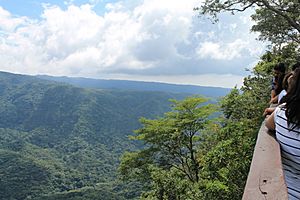
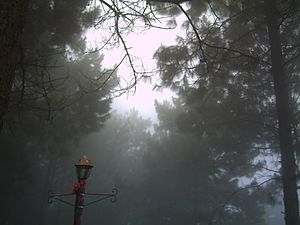
El Salvador is in Central America. It stretches about 270 kilometers (168 miles) from west to east. It is about 140 kilometers (88 miles) from north to south. Its total area is 21,041 square kilometers (8,124 square miles). Because it's the smallest country in continental America, people sometimes call it Pulgarcito de America, which means "Tom Thumb of the Americas." The highest point is Cerro El Pital, which is 2,730 meters (8,957 feet) tall. It sits on the border with Honduras.
El Salvador has a long history of earthquakes and volcanoes. The capital, San Salvador, has been damaged many times by earthquakes. El Salvador has over twenty volcanoes. Two of them, San Miguel and Izalco, have been active recently. For many years, Izalco volcano erupted so regularly that it was called the "Lighthouse of the Pacific." Its bright flares could be seen far out at sea.
The country has over 300 rivers. The most important one is the Rio Lempa. It starts in Guatemala and flows through El Salvador, emptying into the Pacific Ocean. It is the only river in El Salvador that boats can travel on. Other rivers are usually short and flow into the Pacific.
There are several lakes in El Salvador that formed in volcanic craters. The most important ones are Lake Ilopango (70 square kilometers or 27 square miles) and Lake Coatepeque (26 square kilometers or 10 square miles). Lake Güija is the largest natural lake, covering 44 square kilometers (17 square miles). There are also artificial lakes created by dams on the Lempa River, like Embalse Cerrón Grande.
El Salvador shares borders with Guatemala and Honduras. The total length of its borders is 546 kilometers (339 miles). It is the only Central American country that does not have a coastline on the Caribbean Sea. Its Pacific coastline is 307 kilometers (191 miles) long.
Two mountain ranges run across El Salvador from west to east. Between them is a central plateau. A narrow plain runs along the Pacific coast. These features divide the country into two main areas: the interior highlands (mountains and plateau) and the Pacific lowlands (coastal plains).
Climate and Weather
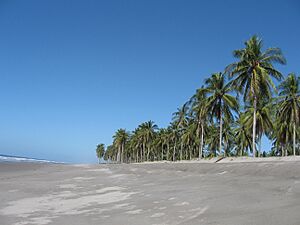

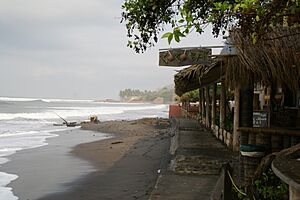

El Salvador has a Tropical climate with clear wet and dry seasons. Temperatures mostly depend on how high up a place is, not on the time of year. The Pacific lowlands are always hot. The central plateau and mountain areas have more moderate temperatures.
The rainy season is from May to October, called invierno (winter). Most of the yearly rain falls during this time. Some mountain slopes facing south can get as much as 2,170 millimeters (85 inches) of rain. Rain usually comes from low-pressure systems over the Pacific. It often falls as heavy afternoon thunderstorms.
From November to April, it's the dry season, called verano (summer). During these months, air from the Caribbean becomes dry as it passes over mountains in Honduras. When this dry air reaches El Salvador, it brings hot, hazy weather. However, in the high northern mountains, like near Cerro El Pital, temperatures are cool. Snow can even fall there sometimes because of the high elevation.
Natural Events
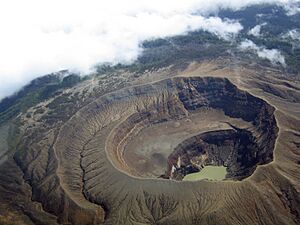
El Salvador's location on the Pacific Ocean means it can experience severe weather. This includes heavy rainstorms and droughts. These can be made worse by El Niño and La Niña weather patterns. Because many trees have been cut down, the land is more likely to have landslides and forest fires.
In 2001, a severe drought destroyed 80% of El Salvador's crops. This caused food shortages in the countryside. In 2005, heavy rains led to dangerous flooding and landslides, causing many deaths.
El Salvador is also in the Pacific Ring of Fire. This means it has a lot of tectonic activity, like frequent earthquakes and volcanic eruptions. For example, an earthquake in January 2001 caused a landslide that killed many people. Another earthquake a month later damaged many homes.
The San Salvador area has been hit by many earthquakes throughout history. The 1986 earthquake left many people without homes.
The most recent big volcanic eruption was in 2005 from the Santa Ana Volcano. It sent out ash, hot mud, and rocks. A much older and more powerful eruption happened around 5th century AD. The Ilopango volcano erupted, causing widespread damage to Mayan cities.
The Santa Ana Volcano is active, with recent eruptions in 1904 and 2005. Lago de Coatepeque, one of El Salvador's lakes, formed in a large volcanic crater.
Animals and Plants
El Salvador is home to many different kinds of animals and plants. There are eight types of sea turtles in the world. Four of these sea turtle species live on the coast of El Salvador. These include the leatherback turtle, the hawksbill, the Green Sea turtle, and the olive ridley. The olive ridley is the most common. The hawksbill and leatherback turtles are very rare and are critically endangered.
It is thought that El Salvador has about 500 types of birds. It also has 1,000 types of butterflies, 400 types of orchids, and 800 types of trees. There are also 800 types of marine fish in its waters.
Economy
El Salvador's economy has faced challenges from natural disasters like earthquakes and hurricanes. The government has worked to improve its finances, focusing on taxes like the value-added tax (IVA). This tax was increased to 13% in 1995.
Antiguo Cuscatlán is a city with a high income per person. It is also a place where international companies invest.
The country's economy has grown steadily. In 2001, the U.S. dollar became legal money in El Salvador alongside the Salvadoran colón. This means that all official money matters are now done in U.S. dollars.
In the past, El Salvador's economy relied heavily on one main export. During colonial times, it was a big exporter of indigo. Later, after synthetic dyes were invented, coffee became the main export for many years.
San Miguel is an important economic center. It hosts the "Carnival of San Miguel," a huge festival with entertainment and food.
Tourism
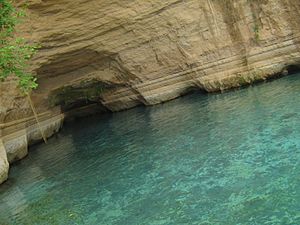
Many tourists visit El Salvador. In 2014, about 1.4 million international tourists were expected to visit. Tourism adds a lot to El Salvador's economy. In 2013, it contributed over $855 million to the country's GDP. Tourism also supports many jobs, both directly and indirectly.
The main airport for international flights is Comalapa International Airport. It is about 40 kilometers (25 miles) southeast of San Salvador.
Most tourists from North America and Europe come to enjoy El Salvador's beaches and nightlife. Surfing has become very popular in recent years. Salvadoran beaches offer great surfing spots that are not too crowded. The use of the United States dollar and direct flights from the U.S. make it easy for American tourists to visit.
The country's culture has also been influenced by American styles. This means you can find many American-style malls, stores, and restaurants in major cities, especially around San Salvador.
Some of the top attractions in El Salvador include its coastal beaches, La Libertad, Ruta Las Flores, Suchitoto, and the Santa Ana Volcano. Other popular spots are Nahuizalco, Apaneca, Juayua, and San Ignacio.
People and Culture
The capital city, San Salvador, has about 2.1 million people. About 42% of El Salvador's population lives in rural areas. However, many people have moved to cities since the 1960s.
Ethnic Groups
El Salvador's population is mostly made up of Mestizos. These are people with mixed Indigenous and European backgrounds. About 86% of Salvadorans are of mestizo ancestry.
Many Salvadorans live outside El Salvador. The United States is a popular place for Salvadorans to move for work. By 2012, about 2 million Salvadoran immigrants lived in the U.S. This makes them the sixth largest immigrant group there. Guatemala is another common destination. Salvadorans also live in Canada, Mexico, and other countries.
Languages
Spanish is the official language and almost everyone speaks it. Some Indigenous people speak their native languages, like Nawat and Maya. However, all of them can also speak Spanish.
The local way of speaking Spanish is called Caliche. Salvadorans use "vos" instead of "tú" for "you," which is also common in Argentina and Costa Rica. Caliche is informal.
Religion
Most people in El Salvador are Christian. The two largest groups are Roman Catholics (47%) and Protestants (33%). About 17% of the population does not belong to any religious group. Other religions include Jehovah's Witnesses, Muslims, and Buddhists. The number of evangelical Christians is growing quickly.
Culture
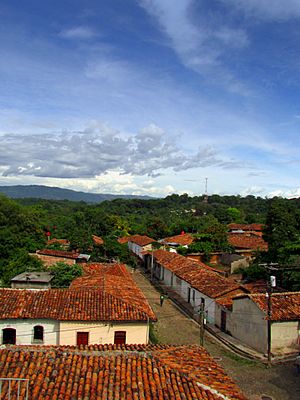
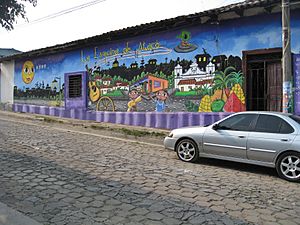
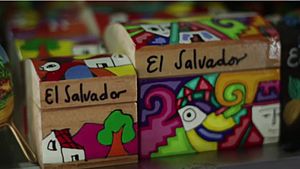
El Salvador's culture is mostly Mestizo. It has strong influences from both Native American Indigenous and European Spanish traditions. The Catholic Church is very important in Salvadoran culture. Archbishop Óscar Romero is a national hero. He worked for peace and justice during a difficult time in El Salvador's history.
Painting, ceramics, and textiles are important art forms. Famous writers include Francisco Gavidia, Salarrué, and Roque Dalton. Notable artists include filmmaker Patricia Chica and painter Fernando Llort.
Cuisine
One of El Salvador's most famous dishes is the pupusa. These are handmade corn tortillas. They are stuffed with things like cheese, chicharrón (fried pork), or refried beans. Sometimes they are filled with queso con loroco, which is cheese mixed with a special vine flower bud called loroco.
Pupusas revueltas have beans, cheese, and pork. There are also vegetarian pupusas. The word pupusa comes from an old Indigenous word, pupushahua. Pupusas were eaten in El Salvador even before the Spanish arrived.
Other typical Salvadoran dishes include yuca frita and panes con pollo. Yuca frita is deep-fried cassava root. It's served with curtido (pickled cabbage) and pork rinds. Pan con pollo/pavo are warm sandwiches filled with marinated and roasted chicken or turkey. They are usually served with tomato, watercress, and other vegetables.
A common Salvadoran breakfast is fried plantain, often served with cream. This is a popular dish in homes and restaurants.
Alguashte is a seasoning made from ground pumpkin seeds. It is used in both savory and sweet dishes.
"Maria Luisa" is a popular dessert. It's a layered cake soaked in orange marmalade and topped with powdered sugar.
A popular drink is Horchata. It's often made from ground morro seeds mixed with milk or water and sugar. Salvadoran horchata has a unique taste and is different from Mexican horchata, which is made from rice. Coffee is also a common morning drink.
Other popular drinks include Ensalada, which is fruit chopped in fruit juice, and Kolachampan, a fizzy drink flavored with sugar cane.
Another popular dessert is Pastel de tres leches (Cake of three milks). It's a cake soaked in three types of milk: evaporated milk, condensed milk, and cream.
Music
Salvadoran music mixes Indigenous Pipil and Spanish influences. It includes religious songs, especially for Christmas and other holidays. Songs often tell stories about rural life. Music from Cuba, Colombia, and Mexico, like salsa and cumbia, is also popular. Traditional Salvadoran music uses instruments like marimba, tehpe'ch, flutes, drums, and gourds. Modern music also uses guitars. The Xuc is a well-known folk dance from Cojutepeque.
Sport
Soccer is the most popular sport in El Salvador. The El Salvador national football team played in the FIFA World Cup in 1970 and 1982. Their qualification for the 1970 tournament happened during a time of tension with Honduras, which was later called the Football War.
The national football team plays at the Estadio Cuscatlán in San Salvador. This stadium opened in 1976 and can hold 53,400 people. It is the largest stadium in Central America and the Caribbean.
Images for kids
-
Excavation of a Megatherium in the Tomayate site Apopa.
-
Skull fossil of an ancient horse in the Tomayate site Apopa.
-
Spanish Conquistador Pedro de Alvarado.
-
Tazumal ruins in Santa Ana, El Salvador.
-
A painting of the First Independence Movement celebration in San Salvador. At the centre, José Matías Delgado.
-
Gen. Tomás Regalado.
-
Archbishop Romero; Romero spoke out for social justice and peace.
-
San Miguel volcano in 2013.
-
The torogoz is El Salvador's national bird.
-
San Miguel is an important economic centre of El Salvador and home to the "Carnival of San Miguel".
See also
 In Spanish: El Salvador para niños
In Spanish: El Salvador para niños




